The Moon’s main features include its cratered surface, extensive volcanic plains (maria), impact-formed mountains, and dusty regolith layer. You’ll notice its unique terminator line where day meets night, creating dramatic shadows. Permanently shadowed regions at the poles contain ice deposits, while tidal locking means you always see the same lunar face from Earth. These features tell a fascinating story of our closest celestial neighbor’s violent 4.5-billion-year history.
The Moon’s Origin and Formation: A Cosmic Collision

While gazing at the Moon on a clear night, you’re witnessing the result of one of the most violent events in our solar system’s history. About 4.5 billion years ago, a Mars-sized object called Theia smashed into Earth, ejecting massive amounts of debris that eventually formed our Moon.
This giant impact hypothesis explains why the lunar surface contains materials similar to Earth’s mantle. The Moon, remarkably large at one-quarter Earth’s diameter, is actually the largest satellite relative to its planet in our solar system.
After ancient volcanic eruptions reshaped its surface, the Moon settled into its current role—stabilizing Earth’s axial tilt and driving our ocean tides. This cosmic partnership began shortly after the solar system formed, making the Moon almost as old as Earth itself.
Lunar Maria: Ancient Volcanic Plains That Look Like Seas
When you look up at the Moon, you’ll notice large dark patches contrasting against the brighter regions—these are lunar maria, ancient volcanic plains that cover about 16% of the lunar surface.
These “seas” aren’t actually filled with water but consist of dark basaltic material that erupted onto the surface between 3 and 4 billion years ago during a period of intense volcanic activity.
Despite their Latin name meaning “seas,” the maria were misidentified by early astronomers who couldn’t have known they were observing the solidified remains of massive lava flows that forever changed the Moon’s appearance.
Dark Basaltic Plains
The dark patches visible on the Moon’s surface aren’t actually seas, despite their Latin name “maria” meaning exactly that.
These large dark areas cover about 16% of the lunar surface and formed over 3 billion years ago when ancient volcanic eruptions filled impact basins with lava.
The dark basaltic plains appear distinct from the brighter highland regions due to their iron-rich composition, which makes them less reflective.
You can easily spot prominent maria like Mare Imbrium (Sea of Showers), Mare Tranquillitatis (Sea of Tranquility), and Oceanus Procellarum (Ocean of Storms) with the naked eye.
While they resemble Earth’s oceans from afar, you won’t find any water in these formations—just solidified volcanic rock that tells the story of the Moon’s violent past.
Ancient Volcanic History
Billions of years ago, a dramatic chapter in lunar history unfolded as molten rock erupted onto the Moon’s surface, creating what we now call the lunar maria.
These vast plains formed between 3 and 4 billion years ago when massive impacts created enormous basins that later filled with basaltic lava.
You can easily spot these dark regions with the naked eye from Earth. Unlike their Latin name meaning “seas,” these areas never contained water.
The maria primarily appear on the Moon’s near side, covering about 16% of the total lunar surface.
What’s remarkable is that you’re seeing virtually unchanged landscape—these ancient volcanic plains have remained preserved for billions of years without weathering or geological activity to erode the flat surfaces and impact craters that dot them.
Impact Craters: The Moon’s Historical Record
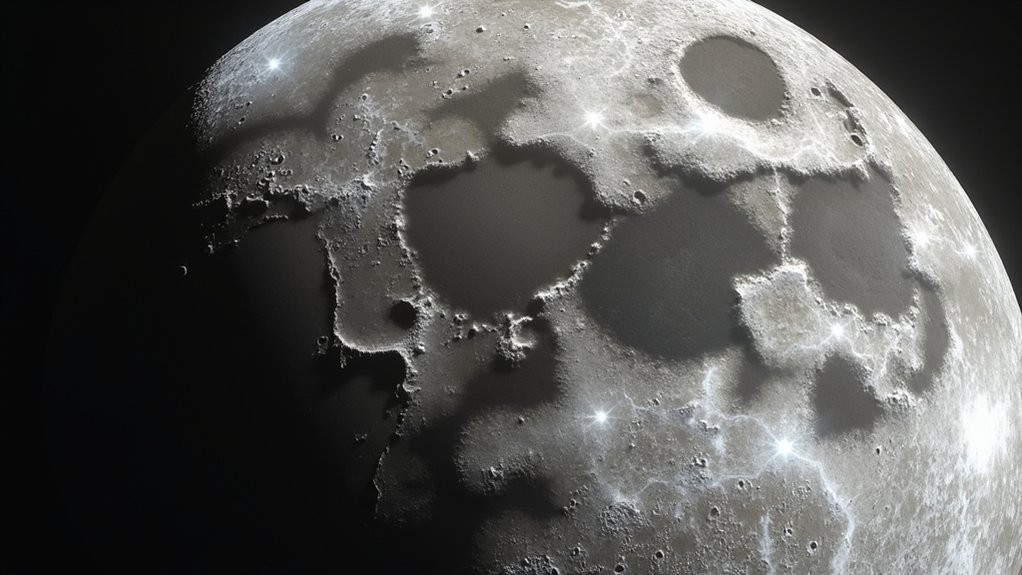
Scattered across our Moon’s barren landscape, impact craters serve as a pristine record of cosmic collisions that have occurred throughout its 4.5 billion-year history.
Unlike Earth, the Moon’s surface preserves these scars perfectly due to the absence of atmosphere and tectonic activity.
The most impressive scar is the South Pole-Aitken Basin, an 8 km deep depression created by an impact over a thousand times more powerful than what killed the dinosaurs.
Many craters display distinctive rays—streaks of ejected material that radiate outward, with Copernicus crater showcasing particularly striking examples.
When you study these lunar impact craters, you’re actually reading a timeline of our solar system’s development—each crater tells the story of a cosmic event frozen in time.
Mountains and Valleys: Rugged Lunar Terrain
Among the most striking features you’ll notice when observing our Moon are its dramatic mountains and valleys, which create a rugged terrain that defines much of the lunar landscape. Unlike Earth’s mountains formed by tectonic activity, lunar mountains result from ancient impacts and can reach impressive heights of up to 3.0 km, as seen in Mons Ampère.
| Feature | Characteristic |
|---|---|
| Mountains | Form from impacts, not tectonics |
| Heights | Up to 3.0 km tall (Mons Ampère) |
| Valleys | Extend hundreds of kilometers |
| Preservation | Retain sharp features for billions of years |
The Moon’s valleys are equally impressive, with Vallis Rheita stretching 445 km and Vallis Planck reaching 451 km. Without weathering processes, these dramatic formations remain virtually unchanged since their creation, preserving the Moon’s ancient topography.
Regolith: The Moon’s Powdery Surface Layer
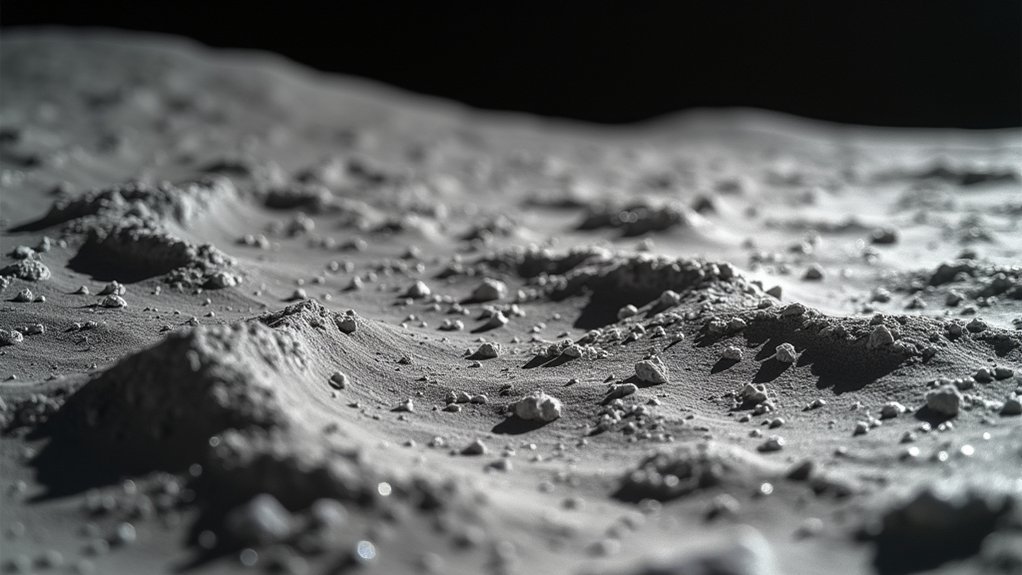
A blanket of fine dust and rocky debris known as regolith covers the entire lunar surface, forming through countless micrometeorite impacts over the Moon’s 4.5-billion-year history. This powdery layer varies in thickness, reaching up to 20 meters deep in some areas.
You’ll find the regolith’s composition resembles Earth’s basalt rock, containing oxygen, silicon, iron, calcium, and magnesium. This highly abrasive material creates significant challenges for lunar exploration equipment and astronaut mobility.
During the Apollo missions, astronauts collected regolith samples that have proven invaluable for understanding the Moon’s geological past.
Scientists have even used these samples in experiments to test whether plants could grow in simulated lunar conditions, offering insights for potential future lunar habitation.
Lunar Phases: How We See Different Parts of the Moon
The Moon’s ever-changing appearance in our night sky follows a predictable pattern known as lunar phases. As our celestial neighbor orbits Earth every 29.5 days, you’ll witness eight distinct phases from New Moon to Waning Crescent.
Lunar phases unfold in an elegant cosmic rhythm, guiding our nights through eight distinct faces of our celestial companion.
These phases occur because we see different portions of the Moon’s sunlit half as it travels around us.
During a New Moon, it sits between Earth and the Sun, appearing nearly invisible. When full, Earth positions between the Moon and Sun, revealing its entire illuminated face—including all visible lunar craters.
Throughout history, humans have used these predictable changes to track time and plan agricultural activities.
Next time you gaze upward, notice which phase brightens your night sky—you’re observing the same cosmic dance that has fascinated humanity for millennia.
Terminator Line: Where Light Meets Shadow
The sweeping terminator line on the Moon offers you a front-row seat to the dramatic interplay of light and shadow where lunar day meets night.
As you observe this boundary, you’re witnessing actual sunrise on Luna, with sunlight gradually climbing over crater rims and mountain peaks.
The stark landscape contrast along this edge reveals the Moon’s topography with exceptional clarity, making features appear in sharp relief that would otherwise be washed out in full illumination.
Sweeping Shadow Boundary
Dividing lunar day from lunar night, the terminator line provides one of the most fascinating phenomena you’ll observe on our Moon. This continuously shifting boundary creates a dramatic contrast that enhances visibility of surface features along its path.
When you view the Moon through binoculars or a telescope, you’ll notice craters and mountains appear more pronounced along this shadow boundary. The stark contrast between light and shadow accentuates topographical details that might otherwise remain subtle or invisible.
The terminator’s width changes throughout the lunar cycle—appearing narrower during a full moon and wider during crescent phases.
For the best lunar observations, focus your attention on this dynamic boundary where shadows reveal the Moon’s texture and depth in striking detail.
Sunrise On Luna
Sunrise on our lunar neighbor offers a spectacle unlike anything we experience on Earth. As the Sun’s rays stretch across the barren landscape, they create the terminator line—that dramatic boundary between day and night that slowly shifts as the Moon orbits around us.
You’ll notice this line reveals lunar features with striking clarity. Without an atmosphere to scatter light, shadows stretch dramatically across craters and mountains, making surface details appear more pronounced than they’d on the surface of the Earth.
Temperature changes across this boundary are extreme, evolving from a scorching 224°F in sunlight to a frigid -244°F in darkness. This sharp contrast creates perfect conditions for studying lunar geology, as features stand out in bold relief at the edge of encroaching light.
Dramatic Landscape Contrast
Along the razor-sharp boundary where day meets night, the Moon’s terminator line presents one of the most visually striking phenomena observable from Earth. This shifting frontier creates dramatic contrast that reveals lunar features with extraordinary clarity.
As sunlight strikes the surface at a shallow angle, craters cast long shadows and mountains stand in bold relief against darkened plains.
You’ll notice the terminator line accentuates topographical variations that might otherwise appear flat under direct illumination. The stark differences between dark maria and lighter highlands become particularly pronounced along this boundary.
As the Moon progresses through its phases, this line continually migrates across the surface, offering you changing perspectives of familiar features.
For lunar photographers and geologists alike, this interplay of light and shadow provides the ideal conditions to study our celestial neighbor’s complex terrain.
Polar Ice Deposits: Water on Our Nearest Neighbor
While most people imagine the Moon as a completely dry and barren world, scientists have made a remarkable discovery that’s changing our understanding of Earth’s closest neighbor. In permanently shadowed regions at the lunar poles, where temperatures plummet to an frigid -388°F, water ice deposits have been detected.
The Moon holds secrets in its darkest, coldest corners—water ice that transforms our lunar ambitions.
These polar ice deposits are particularly exciting for future lunar exploration:
- They’re believed to be remnants of cometary impacts trapped in sunlight-free craters
- You could potentially use this water ice for drinking, oxygen production, and fuel creation
- Scientific missions to both poles have confirmed these resources exist, especially in the South Pole-Aitken Basin
This discovery makes the Moon far more valuable for potential human colonization and long-term missions beyond Earth.
Tidal Locking: Why We Always See the Same Face
One of the Moon’s most peculiar characteristics is that it always presents the same face to Earth, a phenomenon astronomers call tidal locking. This occurs because the Moon’s rotation period perfectly matches its orbital period—both taking approximately 27.3 days to complete.
Earth’s gravitational forces have gradually shaped our satellite over billion years, creating a slight bulge that permanently aligns with our planet. These tidal forces progressively slowed the Moon’s rotation until it reached its current synchronized state.
Interestingly, you don’t always see exactly the same lunar features. Due to slight orbital variations called libration, you can actually observe about 59% of the Moon’s surface over time.
Still, the far side remains perpetually hidden from Earth-based observers.
Frequently Asked Questions
What Are the Major Features of the Moon?
The Moon features dark maria (16% of surface), impact craters like Tycho, the massive South Pole-Aitken Basin, light-colored highlands (83%), and geological formations including valleys such as Vallis Planck (451 km long).
What Are 5 Characteristics of the Earth’s Moon?
You’ll notice five key Moon characteristics: one-sixth Earth’s gravity, extreme temperature variations, no atmosphere, well-preserved impact craters, and dark volcanic plains called maria formed billions of years ago.
What Are 5 Things About the Moon?
You’ll find five fascinating moon facts: it’s Earth’s only satellite, has no atmosphere, contains notable craters and maria, experiences extreme temperatures, and gradually drifts away from Earth at 3.8cm yearly.
What Is Unusual About Our Moon?
Your Moon is unusual because it’s abnormally large for Earth’s size, always shows you the same face, is moving away from Earth yearly, lacks an atmosphere, and has an unexpectedly stable orbit.
In Summary
You’ve now explored the Moon’s fascinating features—from its violent birth to its ancient seas and craters. You’ve learned about its dusty surface, majestic mountains, and hidden ice deposits. When you next gaze upward at our faithful companion, you’ll understand why it’s locked in its eternal dance with Earth, forever showing us the same mysterious face that has captivated humanity for millennia.
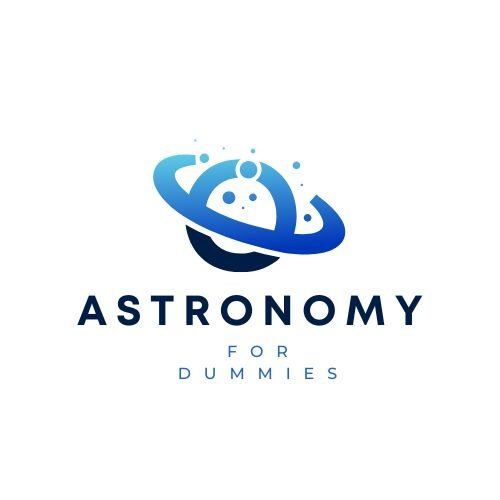

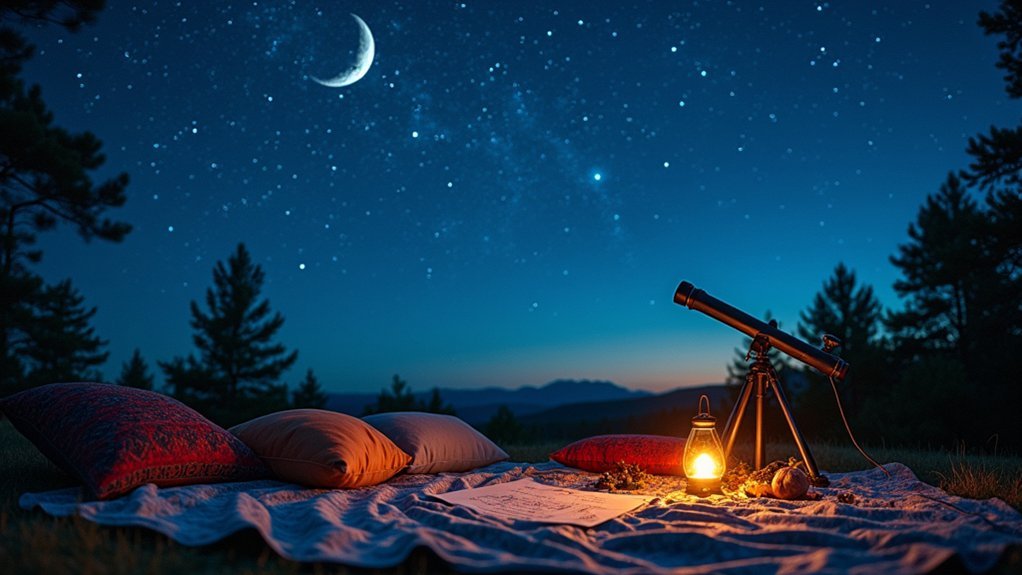
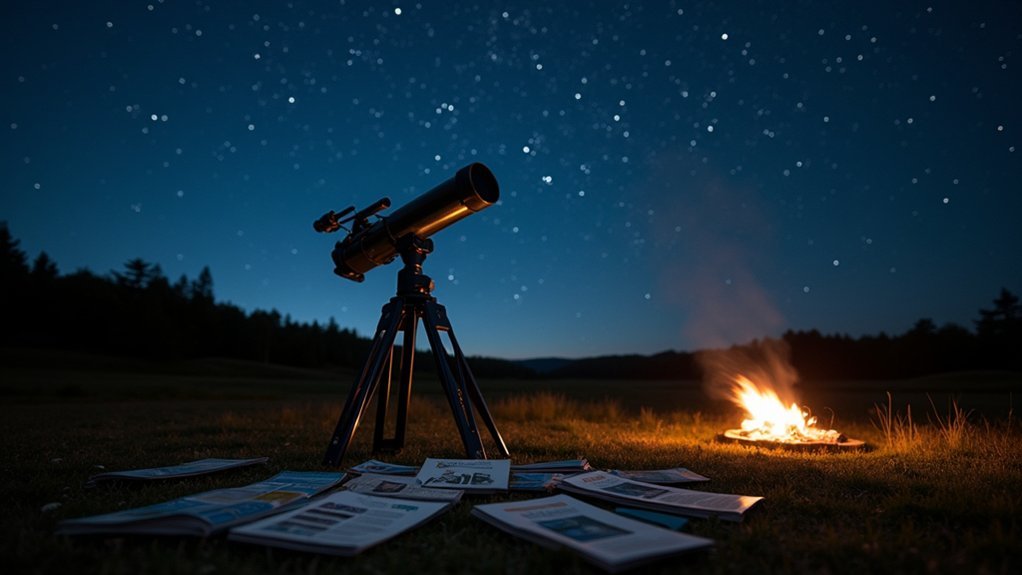
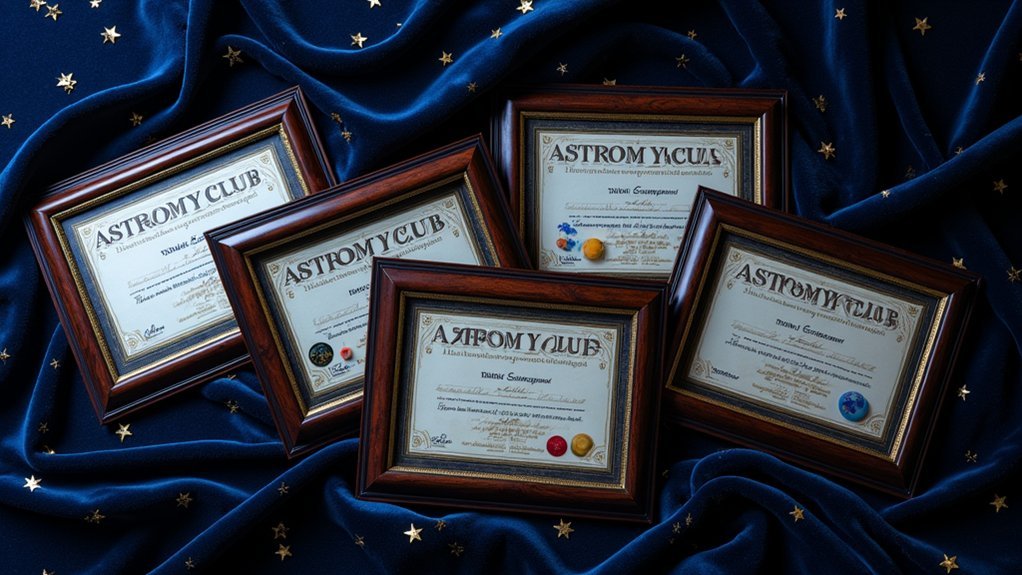
Leave a Reply